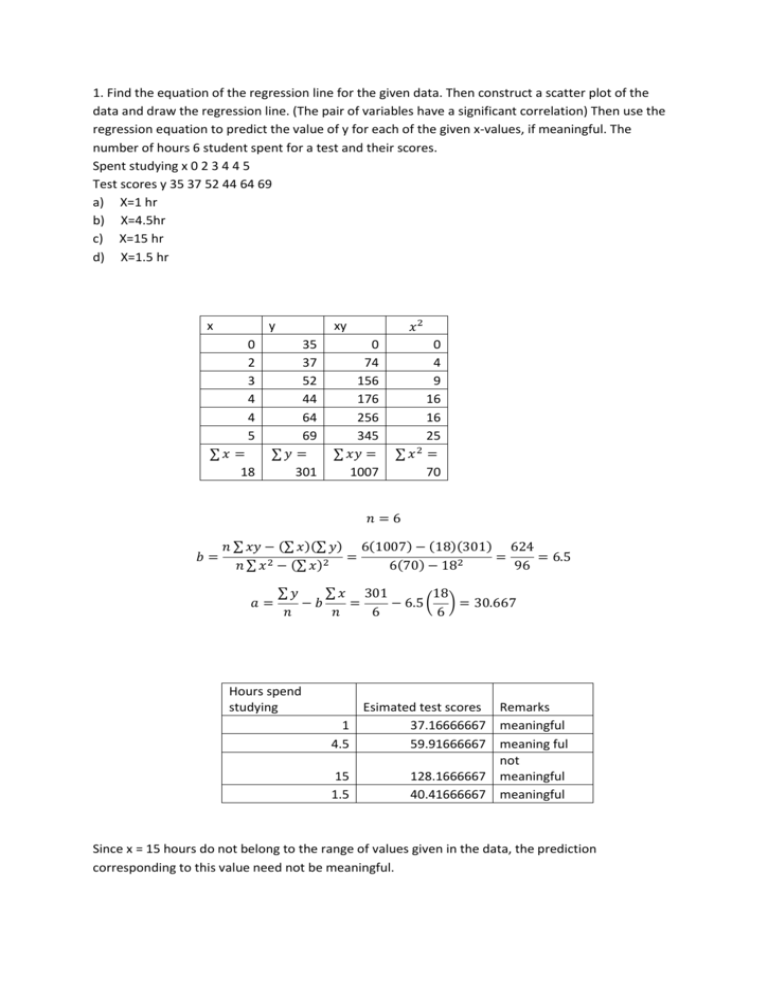1. Find the equation of the regression line for the given data. Then
advertisement

1. Find the equation of the regression line for the given data. Then construct a scatter plot of the data and draw the regression line. (The pair of variables have a significant correlation) Then use the regression equation to predict the value of y for each of the given x-values, if meaningful. The number of hours 6 student spent for a test and their scores. Spent studying x 0 2 3 4 4 5 Test scores y 35 37 52 44 64 69 a) X=1 hr b) X=4.5hr c) X=15 hr d) X=1.5 hr x 0 2 3 4 4 5 ∑𝑥 = 18 𝑥2 y xy 35 37 52 44 64 69 ∑𝑦 = 301 0 74 156 176 256 345 ∑ 𝑥𝑦 = 1007 0 4 9 16 16 25 ∑ 𝑥2 = 70 𝑛=6 𝑏= 𝑛 ∑ 𝑥𝑦 − (∑ 𝑥)(∑ 𝑦) 6(1007) − (18)(301) 624 = = = 6.5 𝑛 ∑ 𝑥 2 − (∑ 𝑥)2 6(70) − 182 96 𝑎= ∑𝑦 ∑ 𝑥 301 18 −𝑏 = − 6.5 ( ) = 30.667 𝑛 𝑛 6 6 Hours spend studying Esimated test scores Remarks 1 37.16666667 meaningful 4.5 59.91666667 meaning ful not 15 128.1666667 meaningful 1.5 40.41666667 meaningful Since x = 15 hours do not belong to the range of values given in the data, the prediction corresponding to this value need not be meaningful. Scatter plot 80 70 y = 6.5x + 30.667 R² = 0.6823 60 50 y 40 30 20 10 0 0 1 2 3 4 5 6 x 2. As part of your work for an environmental awareness group you want to test the claim that the mean waste generated by adults in the county is more than 5 pounds per person per day. In a random sample of 15 adults in the country you find the mean waste generated per person per day is 5.1 pounds and the standard deviation is 1.6 pounds at a=0.10 can you support the claim? Assume the population is normally distributed. Let 𝜇 denote the mean waste in pounds generated by an adult male. 𝐻0: 𝜇 = 5 𝐻1: 𝜇 > 5 𝑛 = 15, 𝑡= 𝑥̅ = 5.1, 𝑠 = 1.6, 𝛼 = 0.10 √𝑛(𝑥̅ − 𝜇0 ) √15(5.1 − 5) = = 0.2421 𝑠 1.6 Degrees of freedom = 15-1=14 𝑝 − 𝑣𝑎𝑙𝑢𝑒 = 0.4061 Critical value of 𝑡 = 1.3450 The computed value of 𝑡 is less than the tabled value. (The p-value is not less than the level of significance). So the null hypothesis cannot be rejected. The data do not support the claim that the mean waste generated by adults in the county is more than 5 pounds per person per day.






![Bellringer Quiz May 18tha[2]](http://s3.studylib.net/store/data/006592480_1-fb41d0c53b12a24f299a4a7c8b3c022b-300x300.png)




